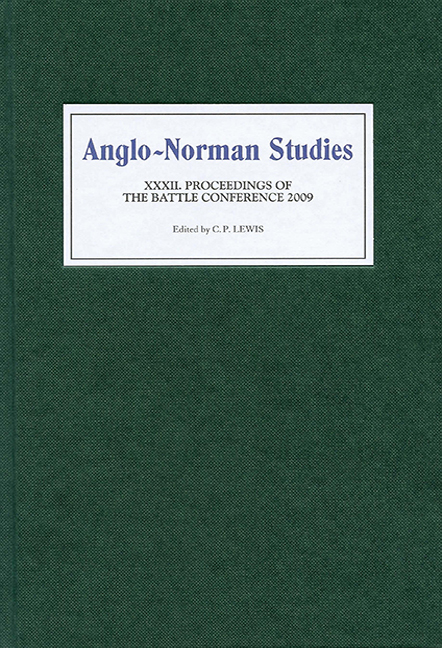Book contents
- Frontmatter
- Contents
- List of Maps and Tables
- Editor's Preface
- Abbreviations
- The Peace of God and Bishops at War in the Gallic Lands from the Late Tenth to the Early Twelfth Century
- Ad erudiendum tradidit: The Upbringing of Angevin Comital Children
- Coming and Going: The Use of Outdoor Space in Norman and Anglo-Norman Chronicles
- The Urban Transformation in England, 900–1100
- The Taming of the Laity: Writing Waltheof and Rebellion in the Twelfth Century
- Close Relations? Some Examples of Trade Links between England and the Towns and Ports of Lower Normandy in the Thirteenth and Early Fourteenth Centuries
- The Roots of the English Royal Forest
- Knighthood and Chivalry in the Histories of the Norman Dukes: Dudo and Benoît
- Prayers for the King and Royal Titles in Anglo-Norman Charters
- Domesday Mortlake
- Miscellaneous Endmatter
The Peace of God and Bishops at War in the Gallic Lands from the Late Tenth to the Early Twelfth Century
Published online by Cambridge University Press: 28 April 2017
- Frontmatter
- Contents
- List of Maps and Tables
- Editor's Preface
- Abbreviations
- The Peace of God and Bishops at War in the Gallic Lands from the Late Tenth to the Early Twelfth Century
- Ad erudiendum tradidit: The Upbringing of Angevin Comital Children
- Coming and Going: The Use of Outdoor Space in Norman and Anglo-Norman Chronicles
- The Urban Transformation in England, 900–1100
- The Taming of the Laity: Writing Waltheof and Rebellion in the Twelfth Century
- Close Relations? Some Examples of Trade Links between England and the Towns and Ports of Lower Normandy in the Thirteenth and Early Fourteenth Centuries
- The Roots of the English Royal Forest
- Knighthood and Chivalry in the Histories of the Norman Dukes: Dudo and Benoît
- Prayers for the King and Royal Titles in Anglo-Norman Charters
- Domesday Mortlake
- Miscellaneous Endmatter
Summary
The ‘Peace of God’ excites the modern imagination. It is thought of as a pacifist movement to abolish a feudal system based on war or halt its progress towards total domination. The Church of the year 1000, so the story goes, faced down the lords and rescued the Capetian kingdom from chaos pending the reinvigoration of kingship around 1100. What a vital moment in social and Christian history it was indeed! The bishops of Aquitaine, Gothia, Burgundy, and France had heard the sighs of the peasant victims of the castle-knights’ warlike pillaging. They summoned them one and all into the presence of holy relics and forced them to swear on the relics that they would keep the peace. Those who bowed to the law of God and swore to respect the holy places and the unarmed had their sins forgiven. Those who refused to swear or, having sworn, went back on their oaths became objects of terrifying malediction. Unfettered social violence was thus met by a vehement religious response, and it was just that, a religious response. The knights had been disarmed by fear of God and the relics of His saints. Such is the historical representation that was canonized by Michelet and given a new lease of life in 1992 by Thomas Head and Richard Landes. Yet it is impossible not to be struck immediately by the often warlike – and simoniacal – behaviour of several of these bishops. Indeed I wonder whether I used strong enough words back in 1999, when I questioned the supposed pacifism of certain bishops between 989 and 1119.
Historians often quote Rodulfus Glaber's praise of the Aquitainian pacts and Ademar of Chabannes's sermons in their favour, but what of the contemporary criticisms levelled at Aimon of Bourges and Hugh of Auxerre, two of their main promoters? Again, it is all very well to enthuse with Suger of Saint-Denis, a century later, about King Louis VI's role as agent of the peace of God of 1111 and 1115. But what about the adverse comments of Guibert of Nogent and Orderic Vitalis, if not about the king himself, then certainly about the bishops who supported him?
True, we have a great deal of documentation. But it is very patchy and rather problematic.
- Type
- Chapter
- Information
- Anglo-Norman Studies XXXIIProceedings of the Battle Conference 2009, pp. 1 - 23Publisher: Boydell & BrewerPrint publication year: 2010

